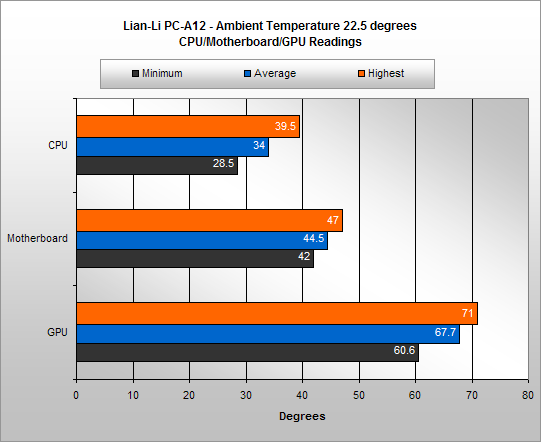Thermal performance
We've decided to throw out our old hot n' toasty test rig and replace it with some new hardware that's more relevant to the current market. Gone is our faithful 975XBX motherboard from Intel to be replaced by copper-adorned chippery in the form of an ASUS P5K Deluxe.
And, graphics has switched so that, now, an ATI card powers our pixels. Below are the full specs.
| HEXUS chassis test equipment specification | |
|---|---|
| Motherboard | ASUS P5K Deluxe |
| Processor | Intel Core2Duo E6750 2.66JGHz 1333MHz FSB |
| Memory | 2GiB (2 x 1GiB) CellShock DDR2 PC8000 |
| Graphic card | HIS Digital 2900XT PCIe |
| Power supply | Corsair HX620W |
| Hard drive | Hitachi GST 250GB SATA x 2 |
| Optical drive | Pioneer 110 DVD rewriter |
With the system booted up, we let the system idle for 15 minutes and then took some readings before putting everything through its paces.
We started off by running SiSoft Sandra Pro's burn-in tests - with ATITool running in the background to ensure that the CPU was running at full tilt.
During testing, ambient temperature was 22.5 deg C

Our new readings mean that rather than just quoting the maximum temperature of the components we will, where possible, provide you with the average, too. The PC-A12 managed to do pretty well in the CPU tests, with the average temperature coming in at 34 deg C.
Due to the fact that our test rig is fitted with a 2900XT graphics card, there is only going to be one winner when it comes to fan noise inside the chassis and indeed - yes, the noise was dominated by the toasty pixel-pusher, not unexpected considering an average temperature of 67.5 degrees during out tests.

Thankfully, the case temperatures were much lower, with only a 2.2 degree increase to 25.7 degrees being noted under load.
Overall, the PC-A12 is a pretty average performer in the thermal tests, with average temperatures nothing out of the ordinary - though we do think that, with some better quality fans, there might be some room for improvement.









